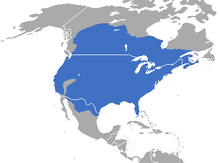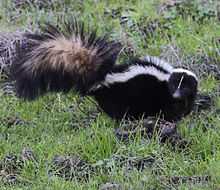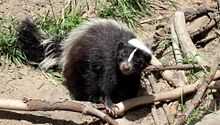Striped skunk
| Striped skunk[1] | |
|---|---|
_DSC_0030.jpg) | |
| Conservation status | |
| Scientific classification | |
| Kingdom: | Animalia |
| Phylum: | Chordata |
| Class: | Mammalia |
| Order: | Carnivora |
| Suborder: | Caniformia |
| Family: | Mephitidae |
| Genus: | Mephitis |
| Species: | M. mephitis |
| Binomial name | |
| Mephitis mephitis (Schreber, 1776) | |
 | |
| Range of Mephitis mephitis | |
The striped skunk (Mephitis mephitis) is an omnivorous mammal of the skunk family Mephitidae. Found north of Mexico, it is one of the best-known mammals in Canada and the United States.[3]
Description

The striped skunk has a black body with a white stripe along each side of its body; the two stripes join into a broader white area at the nape. Its forehead has a narrow white stripe. Similar in size to a domestic cat, this species is the heaviest species of skunk, though it is not as long (in body or tail length) as the American hog-nosed skunk.[4] Adults can weigh from 2.5 to 15 lb (1.1 to 6.8 kg), although the average weight is 6–8 lb (2.7–3.6 kg). The animal's length (excluding the tail) is 13 to 18 in (33 to 46 cm). Males tend to be around 10% larger than females.[5] The bushy tail is 7 to 10 in (18 to 25 cm), and sometimes has a white tip. The presence of a striped skunk is often first made apparent by its odor. It has well-developed anal scent glands (characteristic of all skunks) that can emit a highly unpleasant odor when the skunk feels threatened. Striped skunks have 34 teeth, with the dental formula 3.1.3.13.1.3.2.[6]
Range and ecology

The striped skunk is widespread in North America. Its range includes south Canada from Nova Scotia to British Columbia as well as most of the continental United States and parts of northern Mexico.[5][7] It can be found in elevations up to 1800 m but rarely above 4000 m.[8] Skunks can be found in a number of habitats, including woodlands, grasslands and agricultural lands. The skunk has increased its range with the cutting of forests throughout North America.[5]

The striped skunk is omnivorous and has a varied diet. Its diet consists mostly of insects such as beetles, grasshoppers and crickets.[5][7][9] It also eats earthworms, snails, crayfish, wasps and ants.[5][9] It preys on vertebrates like frogs and small mammals including voles, mice, moles, rats and squirrels.[5][9][10] It also eats bird eggs. Plant matter the skunk eats include blackberries, raspberries, black cherries, blueberries, grains, corn, and nuts.[5] Skunks eat mostly insects and mammals during the spring and summer.[8] During the fall and winter, more plant matter is consumed.[7] In settled areas, skunks also seek human garbage. Less often, skunks may be found acting as scavengers, eating bird and rodent carcasses left by cats or other animals. Pet owners, particularly those of cats, may experience a skunk finding its way into a garage or basement where pet food is kept. Skunks commonly dig holes in lawns in search of grubs and worms.
Skunks are one of the primary predators of the honeybee, relying on their thick fur to protect them from stings. The skunk scratches at the front of the beehive and eats the guard bees that come out to investigate.
Most predatory animals of the Americas, such as wolves, foxes and badgers, seldom attack skunks – presumably out of fear of being sprayed. The exception is the great horned owl—the animal's only serious predator—which, like most birds, has a poor-to-nonexistent sense of smell.
Behavior and reproduction


The skunk is crepuscular. Beginning its search for food at dawn and dusk, it feeds on mice, eggs, carrion, insects, grubs, and berries. At sunrise, it retires to its den, which may be in a ground burrow, or beneath a building, boulder, or rock pile. While the male dens by itself, several females may live together. The striped skunk does not hibernate but instead goes into a dormant or semi-active state. Outside the breeding season, males are solitary and try to build fat reserves while females defend their maternity dens.[5]
Breeding in the skunk mostly occurs from mid-February to mid-April.[5][9] A skunk breeds only once a year.[5][10] Male skunks are polygamous and will mate with several females in succession.[5] When encountering an estrous female, a male will approach her from the rear and then smell and lick the vulva area.[5] The male then grasps the female by the nape and then mounts and copulates with her.[5][10]
Once a female is impregnated she does not allow any more copulations and will fight off any male that tries to mount her.[5] However, females that lose their litters may lead to a later mating.[9] The young are born in May or early June.[9] Skunks tend to have litters of 4 to 8 with 2 and 10 being extremes.[9] The young are born hairless but have their striping pattern.[9] By eight days, the young's musk odor can be emitted. By 22 days, the young's eyes open.[9] After an eight-week nursing, the litter then hunt with their mothers and eventually they disperse.[9]
In captivity

The striped skunk can be kept as a pet in the United States (not all states), Germany, the Netherlands, Italy and the United Kingdom. The striped skunk – but not other species, depending on the province – is illegal to keep as a pet in Canada. Although capable of living indoors with humans similarly to dogs or cats, pet skunks are relatively rare, partly due to restrictive laws and the complexity of their care. Pet skunks are mainly kept in the United States, Germany, the Netherlands, and Italy.
In the United States, pet skunks can be purchased from licensed animal shelters, non-profit skunk educational organizations such as the American Domestic Skunk Association, Inc., or breeders with a permit from the U.S. Department of Agriculture's Animal and Plant Health Inspection Service. Baby skunk availability peaks during springtime, immediately following the skunk mating season. Some large fur farms sell surplus skunks.
Classification and first identification
The striped skunk was first described by Johann Christian Daniel von Schreber in 1776.[11]
Thirteen subspecies of striped skunk are generally recognized:[1]
- M. m. avia Bangs, 1898
- M. m. elongata Bangs, 1895
- M. m. estor Merriam, 1890
- M. m. holzneri Mearns, 1898
- M. m. hudsonica Richardson, 1829
- M. m. major Howell, 1901
- M. m. mephitis Schreber, 1776
- M. m. mesomelas Lichtenstein, 1832
- M. m. nigra Peale and Palisot de Beauvois, 1796
- M. m. notata Hall, 1936
- M. m. occidentalis Baird, 1858
- M. m. spissigrada Bangs, 1898
- M. m. varians Gray, 1837
In popular culture
Skunks have made their way into popular culture, as Flower in Disney's Bambi and Chuck Jones's Pepé Le Pew
References
- ↑ 1.0 1.1 Wilson, D. E.; Reeder, D. M., eds. (2005). Mammal Species of the World (3rd ed.). Johns Hopkins University Press. ISBN 978-0-8018-8221-0. OCLC 62265494.
- ↑ Reid, F. & Helgen, K. (2008). "Mephitis mephitis". IUCN Red List of Threatened Species. Version 2009.2. International Union for Conservation of Nature. Retrieved 2010-01-18.
- ↑ Burt, William H.; Grossenheider, Richard P. A Field Guide to the Mammals (of America North of Mexico). he Petersen Field Guide Series. Houghton Mifflin Company. p. 65. ISBN 0-395-24084-0.
- ↑ Luke, Hunter (2011). Carnivores of the World. Princeton University Press. ISBN 9780691152288.
- ↑ 5.0 5.1 5.2 5.3 5.4 5.5 5.6 5.7 5.8 5.9 5.10 5.11 5.12 5.13 Godin, A. J. 1982. "Striped and hooded skunks." In: J. A. Chapman and G. A. Feldhamer (eds), Wild mammals of North America: biology, management, and economics, pp. 674–687. Johns Hopkins University Press, Baltimore, Maryland, USA.
- ↑ Deloy Roberts. "Skull Collection - Skunk". Skyline High School, Idaho Falls, Idaho. Retrieved 2015-04-17.
- ↑ 7.0 7.1 7.2 Rosatte, R. C. 1987. Striped, Spotted, Hooded, and Hog-nosed Skunk. In: M. Novak, J. A. Baker, M. E. Obbard and B. Malloch (eds), Wild furbearer management and conservation in North America, pp. 1150 pp.. Ontario Ministry of Natural Resources and the Ontario Trappers Association, Ontario, Canada, Toronto, Ontario, Canada.
- ↑ 8.0 8.1 Rue, L. L. 1981. Furbearing animals of North America. Crown Publications, New York, USA.
- ↑ 9.0 9.1 9.2 9.3 9.4 9.5 9.6 9.7 9.8 9.9 Hamilton Jr., W. J. and Whitaker Jr., J. O. 1979. Mammals of the Eastern United States. Cornell University Press, Ithaca, New York, USA.
- ↑ 10.0 10.1 10.2 Verts, B. J. 1967. The biology of the striped skunk. University of Illinois Press, Urbana, USA.
- ↑ ITIS Report. "ITIS Standard Report: Mephitis Mephitis". Retrieved 2010-01-18.
External links
| Wikimedia Commons has media related to Mephitis mephitis. |
| Wikispecies has information related to: Mephitis mephitis |
- Striped Skunk at Animal Diversity Web
- Striped Skunk Tracks
- Smithsonian Institution – North American Mammals: Mephitis mephitis
- Smithsonian Wild: Mephitis mephitis
